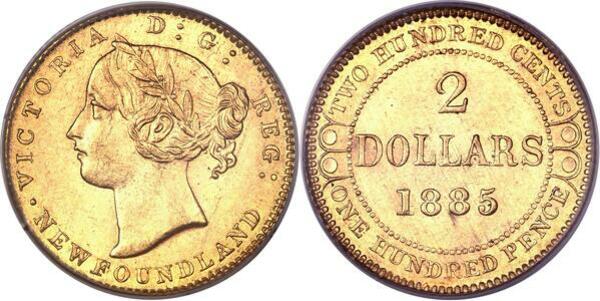The $2 Newfoundland gold coin, minted between 1865 and 1888, is a fascinating piece of Canadian numismatic history. As the only gold coin struck by the colony of Newfoundland, this coin holds a special place in the collections of coin enthusiasts and historians alike.
Historical Context
Newfoundland, a British colony located off the eastern coast of Canada, had its own distinct monetary system in the 19th century. The colony’s decision to issue a $2 gold coin was driven by the need to facilitate trade and commerce, especially given its robust fishing industry and growing economy. The $2 gold coin was part of a broader effort to establish a stable and recognizable currency for the colony.
Design and Specifications
The $2 Newfoundland gold coin features a design that reflects both the colonial heritage and the practical needs of the time. The coin’s obverse typically displays the effigy of Queen Victoria, who reigned during the coin’s production period. The effigy is surrounded by the inscription “VICTORIA D:G: REGINA,” which stands for “Victoria by the Grace of God, Queen.”
The reverse of the coin showcases a crown and wreath design, along with the inscriptions “NEWFOUNDLAND” and the denomination “TWO DOLLARS.” The simplicity and elegance of the design make it a standout piece among 19th-century colonial coins.
The coin weighs approximately 3.328 grams and contains 0.0917 troy ounces of gold, with a diameter of 17.98 millimeters. The fineness of the gold is .917, or 22 karats, which was a common standard for gold coins of the period.
Mintage and Rarity
The $2 Newfoundland gold coin had a limited mintage over its production run, contributing to its rarity and desirability among collectors. The total mintage was relatively small compared to other coins of the era, with fewer than 150,000 coins produced across all years.
The first issuance in 1865 saw a mintage of 10,000 coins, and subsequent years varied in production numbers, with some years having very low mintages. For example, the 1888 issue had only 2,500 coins minted, making it particularly scarce. The rarity of certain dates and the overall limited production make these coins highly sought after.
Collecting and Value
The $2 Newfoundland gold coin is a prized piece for collectors of Canadian and colonial coins. Its value is influenced by factors such as condition, rarity, and historical significance. Coins in better condition, especially those graded by professional services like PCGS or NGC, can fetch higher prices in the market.
Key dates, such as the low-mintage 1888 coin, are especially valuable. Well-preserved examples of these coins can sell for thousands of dollars at auction, reflecting their rarity and the high demand among collectors.
Historical Significance
Beyond its numismatic value, the $2 Newfoundland gold coin is a tangible link to the history of Newfoundland and its economic development in the 19th century. The coin represents a period when Newfoundland was forging its own identity and navigating the challenges of being a small but vital part of the British Empire.
Newfoundland did not join Canada until 1949, so its coinage, including the $2 gold coin, serves as a reminder of its unique historical and economic path. These coins provide insights into the trade practices, monetary policies, and daily life in the colony during that era.
Conclusion
The $2 Newfoundland gold coin is a remarkable piece of North American numismatic history. Its elegant design, limited mintage, and historical significance make it a treasured item for collectors and historians. As a symbol of Newfoundland’s economic aspirations and colonial heritage, this coin continues to captivate and inspire those who appreciate the rich tapestry of history it represents.
